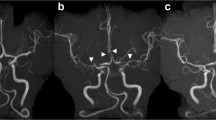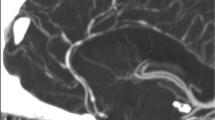Abstract
Reversible cerebral vasoconstriction syndrome (RCVS) is Raynaud's phenomenon of the brain. Changes in neurological function are dependent upon which areas of the brain are deprived of normal blood flow. Antiphospholipid antibody syndrome (APLA) is a common cause of Raynaud's phenomenon that can occur anywhere in the body, including the brain. Management of CNS vasospasm generally involves the use of centrally acting calcium channel blockers, which have been shown to relieve the associated headaches and transient neurological symptoms associated with it. Three patients with APLA and RCVS from our clinics are illustrated. It is demonstrated that the use of centrally acting calcium channel-blocking drugs, such as nimodipine, which prevent and reverse CNS vasospasm, led to clinical improvement in our patients over the course of 5–9 years. All of them had MRIs done at the initiation of therapy and 5–9 years after being on therapy. MRI measures of T2 lesion volumes (LVs) and number were obtained. All three patients had a good response in controlling clinical symptoms related to CNS vasospasm, Raynaud's phenomenon, visual disturbances, confusion, headaches, and hearing loss. There was also a resolution in the MRI findings of these patients. This case series of three patients shows a clinical improvement and decrease in T2 LV and number in patients with APLA and Raynaud's syndrome on centrally acting calcium channel blockers. RCVS is much more common than that currently appreciated. APLA is the common cause of RCVS. Further studies are needed to determine the optimal methods to diagnose RCVS and optimal therapies to treat it.


Similar content being viewed by others
References
Calabrese LH, Dodick DW, Schwedt TJ, Singhal AB (2007) Narrative review: reversible cerebral vasoconstriction syndromes. Ann Intern Med 146(1):34–44
Chen SP, Fuh JL, Wang SJ (2011) Reversible cerebral vasoconstriction syndrome: current and future perspectives. Expert Rev Neurother 11(9):1265–1276. doi:10.1586/ern.11.112
Ducros A, Boukobza M, Porcher R, Sarov M, Valade D, Bousser MG (2007) The clinical and radiological spectrum of reversible cerebral vasoconstriction syndrome. A prospective series of 67 patients. Brain: J Neurol 130(Pt 12):3091–3101. doi:10.1093/brain/awm256
Garcin B, Clouston J, Saines N (2009) Reversible cerebral vasoconstriction syndrome. J Clin Neurosci 16(1):147–150. doi:10.1016/j.jocn.2008.03.014
Hajj-Ali RA, Calabrese LH (2009) Central nervous system vasculitis. Curr Opin Rheumatol 21(1):10–18. doi:10.1097/BOR.0b013e32831cf5e6
Singhal AB, Hajj-Ali RA, Topcuoglu MA, Fok J, Bena J, Yang DS, Calabrese LH (2011) Reversible cerebral vasoconstriction syndromes analysis of 139 cases. Arch Neurol 68(8):1005–1012. doi:10.1001/archneurol.2011.68
Chen SP, Fuh JL, Wang SJ, Tsai SJ, Hong CJ, Yang AC (2011) Brain-derived neurotrophic factor gene Val66Met polymorphism modulates reversible cerebral vasoconstriction syndromes. PloS One 6(3):e18024. doi:10.1371/journal.pone.0018024
Boey ML, Colaco CB, Gharavi AE, Elkon KB, Loizou S, Hughes GR (1983) Thrombosis in systemic lupus erythematosus: striking association with the presence of circulating lupus anticoagulant. Br Med J 287(6398):1021–1023
Wilson WA, Gharavi AE, Koike T, Lockshin MD, Branch DW, Piette JC, Brey R, Derksen R, Harris EN, Hughes GR, Triplett DA, Khamashta MA (1999) International consensus statement on preliminary classification criteria for definite antiphospholipid syndrome: report of an international workshop. Arthritis Rheum 42(7):1309–1311. doi:10.1002/1529-0131(199907)42:7<1309::AID-ANR1>3.0.CO;2-F
Utz VM, Tang J (2011) Ocular manifestations of the antiphospholipid syndrome. Br J Ophthalmol 95(4):454–459. doi:10.1136/bjo.2010.182857
Uthman I, Godeau B, Taher A, Khamashta M (2008) The hematologic manifestations of the antiphospholipid syndrome. Blood Rev 22(4):187–194. doi:10.1016/j.blre.2008.03.005
Urbanus RT, Siegerink B, Roest M, Rosendaal FR, de Groot PG, Algra A (2009) Antiphospholipid antibodies and risk of myocardial infarction and ischaemic stroke in young women in the RATIO study: a case–control study. Lancet Neurol 8(11):998–1005. doi:10.1016/s1474-4422(09)70239-x
Tincani A, Balestrieri G, Danieli E, Faden D, Lojacono A, Acaia B, Trespidi L, Ventura D, Meroni PL (2003) Pregnancy complications of the antiphospholipid syndrome. Autoimmunity 36(1):27–32
Tektonidou MG, Malagari K, Vlachoyiannopoulos PG, Kelekis DA, Moutsopoulos HM (2003) Asymptomatic avascular necrosis in patients with primary antiphospholipid syndrome in the absence of corticosteroid use—a prospective study by magnetic resonance imaging. Arthritis Rheum 48(3):732–736
Sinico RA, Cavazzana I, Nuzzo M, Vianelli M, Napodano P, Scaini P, Tincani A (2010) Renal involvement in primary antiphospholipid syndrome: retrospective analysis of 160 patients. Clin J Am Soc Nephrol 5(7):1211–1217. doi:10.2215/cjn.00460110
Palomo I, Segovia F, Ortega C, Pierangeli S (2009) Antiphospholipid syndrome: a comprehensive review of a complex and multisystemic disease. Clin Exp Rheumatol 27(4):668–677
Miesbach W (2008) Neurologic symptoms as a feature of the antiphospholipid syndrome. Semin Thromb Hemost 34(3):286–289. doi:10.1055/s-0028-1082273
Levine JS, Branch DW, Rauch J (2002) Medical progress: the antiphospholipid syndrome. N Engl J Med 346(10):752–763
Cervera R, Piette JC, Font J, Khamashta MA, Shoenfeld Y, Camps MT, Jacobsen S, Lakos G, Tincani A, Kontopoulou-Griva I, Galeazzi M, Meroni PL, Derksen RH, de Groot PG, Gromnica-Ihle E, Baleva M, Mosca M, Bombardieri S, Houssiau F, Gris JC, Quere I, Hachulla E, Vasconcelos C, Roch B, Fernandez-Nebro A, Boffa MC, Hughes GR, Ingelmo M (2002) Antiphospholipid syndrome: clinical and immunologic manifestations and patterns of disease expression in a cohort of 1,000 patients. Arthritis Rheum 46(4):1019–1027
Hughes GRV (2008) Hughes syndrome (the antiphospholipid syndrome) ten clinical lessons. Autoimmun Rev 7(3):262–266
Mayer M, Cerovec M, Rados M, Cikes N (2010) Antiphospholipid syndrome and central nervous system. Clin Neurol Neurosurg 112(7):602–608. doi:10.1016/j.clineuro.2010.03.023
Meroni PL (2008) Pathogenesis of the antiphospholipid syndrome: an additional example of the mosaic of autoimmunity. J Autoimmun 30(1–2):99–103
Girardi G, Redecha P, Salmon JE (2004) Heparin prevents antiphospholipid antibody-induced fetal loss by inhibiting complement activation. Nat Med 10(11):1222–1226
Lim W (2011) Complement and the antiphospholipid syndrome. Curr Opin Hematol 18(5):361–365. doi:10.1097/MOH.0b013e3283497f3e
Atsumi T, Khamashta MA, Haworth RS, Brooks G, Amengual O, Ichikawa K, Koike T, Hughes GR (1998) Arterial disease and thrombosis in the antiphospholipid syndrome: a pathogenic role for endothelin 1. Arthritis Rheum 41(5):800–807. doi:10.1002/1529-0131(199805)41:5<800::AID-ART5>3.0.CO;2-J
Flammer J, Pache M, Resink T (2001) Vasospasm, its role in the pathogenesis of diseases with particular reference to the eye. Prog Retin Eye Res 20(3):319–349
Bakst R, Merola JF, Franks AG Jr, Sanchez M (2008) Raynaud's phenomenon: pathogenesis and management. J Am Acad Dermatol 59(4):633–653. doi:10.1016/j.jaad.2008.06.004
Rovaris M, Viti B, Ciboddo G, Gerevini S, Capra R, Iannucci G, Comi G, Filippi M (2000) Brain involvement in systemic immune mediated diseases: magnetic resonance and magnetisation transfer imaging study. J Neurol Neurosurg Psychiatry 68(2):170–177
Stosic M, Ambrus J, Garg N, Weinstock-Guttman B, Ramanathan M, Kalman B, Minagar A, Munschauer FE, Galey TM, Hussein S, Bakshi R, Zivadinov R (2010) MRI characteristics of patients with antiphospholipid syndrome and multiple sclerosis. J Neurol 257(1):63–71. doi:10.1007/s00415-009-5264-6
Mandell DM, Matouk CC, Farb RI, Krings T, Agid R, Terbrugge K, Willinsky RA, Swartz RH, Silver FL, Mikulis DJ (2011) Vessel wall MRI to differentiate between reversible cerebral vasoconstriction syndrome and central nervous system vasculitis: preliminary results. Stroke J Cereb Circ. doi:10.1161/STROKEAHA.111.626184
Chen SP, Fuh JL, Lirng JF, Chang FC, Wang SJ (2006) Recurrent primary thunderclap headache and benign CNS angiopathy: spectra of the same disorder? Neurology 67(12):2164–2169. doi:10.1212/01.wnl.0000249115.63436.6d
Feng L, Fitzsimmons BF, Young WL, Berman MF, Lin E, Aagaard BDL, Duong H, PileSpellman J (2002) Intraarterially administered verapamil as adjunct therapy for cerebral vasospasm: safety and 2-year experience. Am J Neuroradiol 23(8):1284–1290
Disclosures
None.
Author information
Authors and Affiliations
Corresponding author
Additional information
All authors participated in the writing of this manuscript.
Rights and permissions
About this article
Cite this article
Gupta, S., Zivadinov, R., Ramasamy, D. et al. Reversible cerebral vasoconstriction syndrome (RCVS) in antiphospholipid antibody syndrome (APLA): the role of centrally acting vasodilators. Case series and review of literature. Clin Rheumatol 33, 1829–1833 (2014). https://doi.org/10.1007/s10067-013-2434-9
Received:
Accepted:
Published:
Issue Date:
DOI: https://doi.org/10.1007/s10067-013-2434-9




